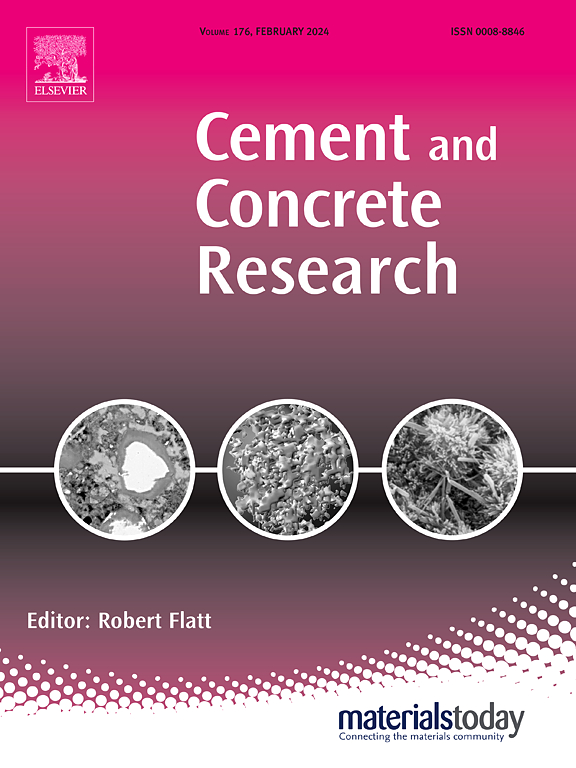Revealing the relationships between transport properties and microstructure characteristics in low-clinker binders before and after carbonation
IF 13.1
1区 工程技术
Q1 CONSTRUCTION & BUILDING TECHNOLOGY
引用次数: 0
Abstract
This study investigates why mass transport properties differ between Portland cement (PC) and low-clinker binders before and after carbonation by examining their underlying microstructural characteristics. Mass transport parameters (sorption rate, oxygen permeability, and chloride migration) were evaluated for non‑carbonated and carbonated mortars made with PC and low-clinker binders (fly ash, slag, limestone-calcined clay, and fly ash–slag composites) at water-to-binder ratios of 0.4, 0.5, and 0.6. Complementary microstructural analyses included mercury intrusion porosimetry (MIP), N₂ adsorption, saturation degree, pore-connectivity factor, and water-accessible porosity. For non‑carbonated mortars, no generalized correlation was found between transport properties and microstructure due to the varying effects of different SCMs on critical/threshold pore diameter, pore-connectivity, and pore surface/solution interaction with transporting media. However, incorporating material coefficients (based on transport mechanism) alongside porosity resulted in a strong correlation across different mixes. After carbonation, low-clinker binders exhibited increased transport due to coarsened pore structures, higher connectivity, and reduced interaction of transporting media with pore surface/solution. Furthermore, a generalized correlation was found between mass transport properties and microstructural parameters in carbonated mortars across all mass transport mechanisms, indicating that microstructural differences from SCMs addition diminish after carbonation. Carbonation results in homogenizing key features such as hygroscopicity and pore surface/solution interaction with transporting media. Additionally, in carbonated mortars, pore-connectivity, bulk conductivity, and critical/threshold pore diameter can be treated as functions of total porosity, enabling the development of cement-independent mass transport models.
揭示了碳化前后低熟料输运特性与微观结构特征的关系
本研究通过分析硅酸盐水泥(PC)和低熟料粘结剂的微观结构特征,探讨了碳化前后质量输运特性不同的原因。在水胶比分别为0.4、0.5和0.6的情况下,对由PC和低熟料(粉煤灰、矿渣、石灰石煅烧粘土和粉煤灰-矿渣复合材料)制成的非碳化和碳化砂浆进行了质量传输参数(吸附速率、氧渗透率和氯离子迁移)评估。补充的微观结构分析包括汞侵入孔隙度(MIP)、N₂吸附、饱和度、孔隙连通性因子和水可达孔隙度。对于非碳化砂浆,由于不同的SCMs对临界/阈值孔径、孔隙连通性以及孔隙表面/溶液与输送介质的相互作用的不同影响,输运特性与微观结构之间没有普遍的相关性。然而,将材料系数(基于输运机制)与孔隙率结合在一起,会导致不同混合料之间的相关性很强。碳化后,低熟料粘结剂由于孔隙结构变粗、连通性提高、输运介质与孔表面/溶液的相互作用减少,输运量增加。此外,在所有质量传递机制中,碳化砂浆的质量传递特性与微观结构参数之间存在普遍的相关性,表明碳化后添加SCMs的微观结构差异减小。碳化作用导致均匀化的关键特征,如吸湿性和孔表面/溶液与输送介质的相互作用。此外,在碳酸化砂浆中,孔隙连通性、体积导电性和临界/阈值孔径可以视为总孔隙度的函数,从而可以开发与水泥无关的质量输运模型。
本文章由计算机程序翻译,如有差异,请以英文原文为准。
求助全文
约1分钟内获得全文
求助全文
来源期刊

Cement and Concrete Research
工程技术-材料科学:综合
CiteScore
20.90
自引率
12.30%
发文量
318
审稿时长
53 days
期刊介绍:
Cement and Concrete Research is dedicated to publishing top-notch research on the materials science and engineering of cement, cement composites, mortars, concrete, and related materials incorporating cement or other mineral binders. The journal prioritizes reporting significant findings in research on the properties and performance of cementitious materials. It also covers novel experimental techniques, the latest analytical and modeling methods, examination and diagnosis of actual cement and concrete structures, and the exploration of potential improvements in materials.
 求助内容:
求助内容: 应助结果提醒方式:
应助结果提醒方式:


